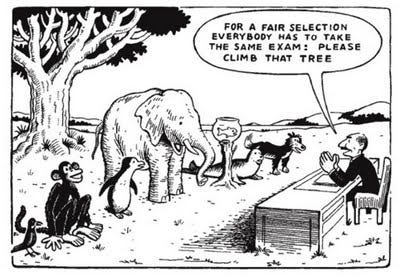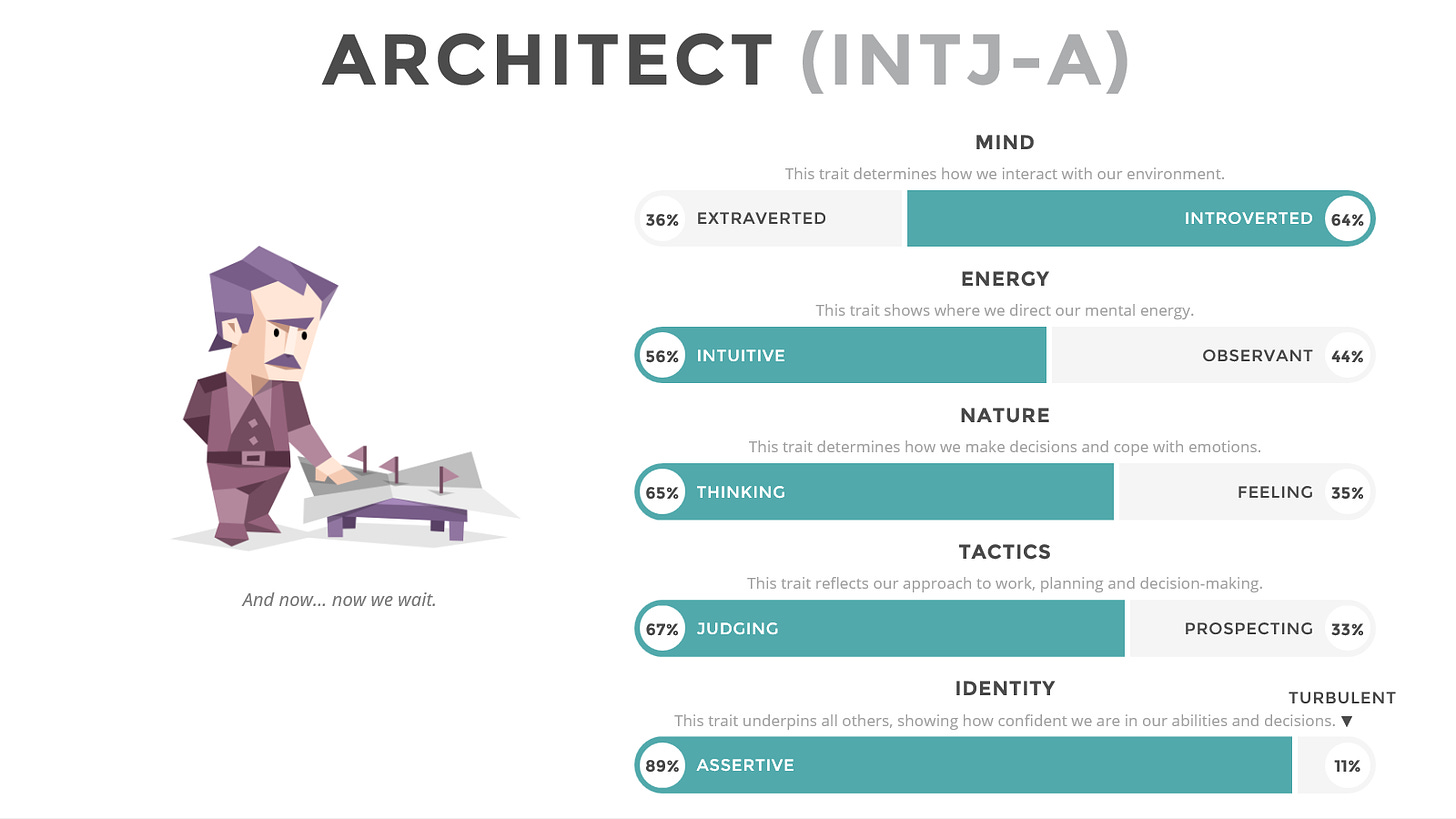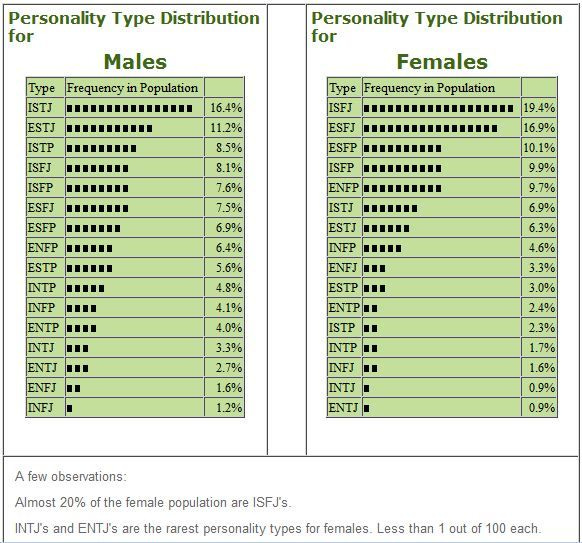Myers Briggs — Part 2: An Introduction To Cognitive Functions
what Cognitive Functions are, how they fit into MBTI, and detailed descriptions of each
This is part two of a four part series.
Part 1: Myers Briggs Is a Failure — an introduction to why MBTI is useful and worth reclaiming from pop psychology.
Part 2: An Introduction to Cognitive Functions — what Cognitive Functions are, how they fit into MBTI, and detailed descriptions of each.
Part 3: Maximizing Your Type – eight concepts and tools for making the most of your type.
Part 4: Typing Yourself Properly – how to know if you’re mistyped and how to fix it.
With the introduction to MBTI laid out in part one, we can now open the door to the really cool stuff: Cognitive Functions.
First, two quick disclaimers:
One: the length of this piece may seem daunting but know that 75% of it is descriptions of each function, half of which you don’t have. Thus, your first read through should only take a few minutes.
Two…
This Is A Beginners Guide
This piece is aimed at giving you the least amount of information necessary to learn and apply Cognitive Functions in your life.
If you are looking for a deep dive into “theory” there are dozens of resources out there. I recommend starting here or here.
But based on my experience applying and teaching this subject personally and professionally for the last decade, I’ve found that a beginner’s guide need only cover:
What Cognitive Functions are
How they fit into MBTI
Which subset of them you personally use
Detailed descriptions of each
So that’s what we’ll be focusing in this piece. If that sounds good with you, keep reading.
Introduction To Cognitive Functions
So what are Cognitive Functions?
Cognitive Functions are “mental strategies” that determine how you interpret and organize new information and experiences (input) as well as how you plan, prioritize, and ultimately take action in your behavior (output).1
Some key things to know about them:
There are eight of them, but you personally only “use” four
Which four you “use” is mostly set in stone by early childhood
Of your four, you rely mostly on one, your “dominant” function
Next, let’s look at how they fit into MBTI.
How Functions Fit Into MBTI
Recall from part one that there are sixteen personalities in MBTI. These sixteen translated into their respective function “stacks” are as follows:
INFJ – Ni, Fe, Ti, Se
INTJ – Ni, Te, Fi, Se
ISFJ – Si, Fe, Ti, Ne
ISTJ – Si, Te, Fi, Ne
ENFJ – Fe, Ni, Se, Ti
ENTJ – Te, Ni, Se, Fi
ESTJ – Te, Si, Ne, Fi
ESFJ – Fe, Si, Ne, Ti
ISFP – Fi, Se, Ni, Te
ISTP – Ti, Se, Ni, Fe
ESFP - Se, Fi, Te, Ni
ESTP - Se, Ti, Fe, Ni
ENTP - Ne, Ti, Fe, Si
ENFP - Ne, Fi, Te, Si
INFP - Fi, Ne, Si, Te
INTP - Ti, Ne, Si, Fe
Pro Tip: when speaking about functions, they are referred to by their short hand, enunciating each letter. Eg Ni is “enn eye”, Ne is “enn ee”, Si “ess eye”, Se “ess ee” and so on.
Some key things to notice:
All personalities have four functions. One N (iNtuitive), one Sensing (S), one Thinking (T) and one Feeling (F) function.
Functions are either introverted (i) or extroverted (e). Each personality has two of each and they are staggered ieie or eiei.
Combining these two things in different orders or “dominances” derives all sixteen personalities.
Why this matters:
Everyone thinks, feels, intuits, and senses. Your MBTI is just a matter of which ones you “do the most” and whether you do them in an extroverted or introverted fashion.
You use your extroverted functions to interface with others and introverted functions to interface with yourself.
Your dominant function determines which domain you prefer (eg “Extroverts” prefer to focus outwardly because their dominant function is extroverted. Introverts, vice versa).
Fun Fact: Your dominant function alone “sets” three of your four MBTI axes. For example, All Ni dominants are INxJ’s, all Se dominants are ESxP’s, all Te dominants are ExTJ’s, all Ti dominants IxTP’s, etc. Your second function will set the remaining letter.
We will come back to these concepts in part three on maximizing your personality, but for now this should be all the conceptual stuff you need to get started.
Now, one last piece of advice before diving into the function descriptions…
How To Use This Next Section
Prior to reading the detailed function descriptions below you should take the sixteen personalities test and focus primarily on the four functions specific to your MBTI (listed above).
Recall from part one my advice to save the screenshots of your result with percentages.
The descriptions below of your dominant function should feel “extremely me”, your auxiliary (secondary) at least “fairly me”, your tertiary (third) “somewhat me”, while your inferior (fourth) is unlikely to register much if at all.
If you don’t find this to be the case, you are probably mistyped and will need to read Part four which will use your percentages to reverse engineer your “true” type.
The Eight Cognitive Functions in Detail
Ni – Introverted Intuition aka “Perspective”
DESCRIPTION: Ni seeks to predict future experience by creating order, building cognitive frameworks, and taking the complex and organizing it into axioms and principles. It distills the “essence” of things and fits them into hierarchical, mental trees. Ni is the second most intolerant function of disorder and change (Si the most).
GREATEST STRENGTHS: Foreseeing the future implications of current events and behaviors with minimal data. Outlining patterns, trajectory paths, and expected results for its user and those around them.
DOMINANTS PRESENT AS: Obsessive, critical, intense, focused, and ambitious. Highly structured, orderly, and minimalist. While they can be highly interested in the past (eg history), their interest lies almost exclusively in extracting principles from it to predict or create the future. Second most likely type to be diagnosed on the Autism Spectrum (Ti dominants first).
GREATEST WEAKNESSES: “No chill”. Unable to “appreciate the now”. Neglect their physical state, immediate world, or relationships because they are too busy obsessing over some idea or goal. They often are high achievers, but at the expense of their relationships, physical health, or happiness.
DOMINANT EXAMPLES: Most CEO’s, “philosophers”, “visionaries”, and nonfiction writers. Most evil dictators and cult leaders.
Ne – Extroverted Intuition aka “Exploration”
DESCRIPTION: In contrast to Ni, Ne seeks novelty of experience; to encounter as many different intellectual and physical environments, situations, and stimuli as possible. It revels in possibility and takes little issue with contradiction. To Ne: the fun lies in the unknown and the mystery and tends to see all situations as opportunity and all failures as learning experience.
GREATEST STRENGTHS: Mastery of inference; able to completely disregard the shackles of “what is” to see the infinite possibilities of “what could be”. Remarkable ability to adapt to the unexpected, stay positive, and defy impossible odds.
DOMINANTS PRESENT AS: Adventurous, curious, mischievous, dreamers. Enjoy pranks, irony, exploration, and “will try anything once”. Often lead highly idiosyncratic and unusual lives. Breakers of all the rules, but rarely intentionally—more because they just don’t even know they’re there. Always have forty chrome tabs open pursuing a dozen completely disparate things. Most likely type to be diagnosed with ADHD.
GREATEST WEAKNESSES: Perpetually distracted by “the new shiny thing”. Struggle to follow through on commitments. Lives often disorganized and full of half finished projects. Second most prone to addiction (behind Se dominants). High risk of spiraling off into the abyss of disorder and chaos.
DOMINANT EXAMPLES: Most entrepreneurs and creatives. Most crazy people who have lost all connection to reality.
Si – Introverted Sensing aka “Memory”
DESCRIPTION: Si, in stark contrast to Ne, seeks consistency of experience. To achieve routine, stability, order, and reliability. Si, like Ni, “creates order” but does so by categorizing past experiences into neat little boxes (habits, routines, and memories) rather than future focused hierarchical frameworks. Si is the function most intolerant of disorder or change.2
GREATEST STRENGTHS: Organizing, cataloging, and managing what is known (“mastering mapped territory”). Having a plan for every possible mishap. Can learn to tolerate most anything. Dutifully and diligently working behind the scenes to keep the machine of the world running, rather than succumbing to lawlessness and chaos.
DOMINANTS PRESENT AS: Organized, dependable, structured, prepared, and risk-averse. Big fans of clear instructions, the “tried and true”, following and enforcing rules. Most hold tradition or conservative values in high regard. Adept at appreciating their past (sentimental and nostalgic) and having gratitude. Most likely type to be diagnosed with OCD.
GREATEST WEAKNESSES: Struggle to let go of old people, ideas, or behaviors long after they are no longer effective. Prone to working hard rather than smart. Prone to getting stuck reminiscing about “what was” at the expense of “what is” (the present) or “what can be” (the future). Most likely to appeal to the idea of “just doing my job” or “just following the rules” as a way of avoiding responsibility for bad outcomes in their lives or occupations.
DOMINANT EXAMPLES: Most people. One-fourth of the worlds population has Si as their dominant function (ISxJs) and half have it in their top two (xSxJs). ISFJ alone accounts for one-fifth of all women, and xSFJ one-third, hence the persistent stereotype of “organized, kind, and dutiful housewife”. Similarly, xSTJ’s account for one-fourth of all men, hence the “classic dad moves” stereotype.
Se – Extroverted Sensing aka “Sensation”
DESCRIPTION: In contrast to Si seeking consistency and Ne seeking novelty, Se seeks intensity of experience. Se doesn’t mind encountering the same stimulus repeatedly as long as it remains a wild f—king ride. In the “masculine” form this manifests as a drive toward competition, thrill, risk, and challenge, and in the “feminine” form as a drive toward powerful spiritual, emotional, and relational experiences.
GREATEST STRENGTHS: Seizing opportunities as they come, engaging with the present moment, “living life to its fullest”. Putting their physical (masculine) or emotional (feminine) stability and safety at risk to experience, challenge, or otherwise deeply engage with powerful, vulnerability-inducing forces. In their eyes such risk is at worst a worthy experience before death and at best will lead to great reward (wealth, glory, true love, etc).
DOMINANTS PRESENT AS: fun, exciting, confident, and bold. Aware of the rules but often break them in pursuit of thrill or because “f—k you you’re not the boss of me!”. Even those not jumping from planes or driving race cars will have some high sensation inducing hobby that makes them “feel alive” like an extreme sport, heavy partying, or intense spiritual practice. Most likely type to be diagnosed with ODD. Second most likely type to be diagnosed with ADHD (Ne is first).
GREATEST WEAKNESSES: Struggle to foresee how their behavior will impact their future or those around them. Failing to “do the hard thing now to benefit them later”. Most prone to addiction. Lose interest in things once they are no longer stimulating. “Burn hot and die out quickly” in their relationships and careers (and sometimes their lives as a whole).
DOMINANT EXAMPLES: Warriors, athletes, “adrenaline junkies”, “party animals”. Also most criminals. One-third of all men have Se in their top two, hence the stereotypical “masculine bravado” and “thrill seeking” commonly associated with men (as well as their overrepresentation in the prison population).
Ti – Introverted Thinking aka “Accuracy”
DESCRIPTION: Ti seeks logical consistency. To Ti, accuracy, understanding, and precision are the highest goods. Ti is sometimes called “my reasoning” or “how does it work?” (In contrast to Te’s “other’s reasoning” or “how can I make it work for me?”). To Ti, determining the inner workings of some system is reward in itself and it will pursue knowledge and accuracy above all else.
GREATEST STRENGTHS: Figuring out the mechanisms of nature and weeding out contradiction, inconsistency, and error from the world. Most great technological and engineering breakthroughs are made by one of them. Able to easily sidestep human barriers like “that’s how we’ve always done it” or “so and so will get upset if we change it”.
DOMINANTS PRESENT AS: logical, systematic, and objective to a fault. Sometimes more cautious about unmapped territory, but after thorough analysis will often end up surpassing the pack with their careful and unmatched precision. Quirky, sometimes with a schizotypal affect. Most likely type to be diagnosed on the Autism Spectrum.
GREATEST WEAKNESS: Getting stuck in states of “analysis paralysis” leading to anxiety and stagnation, especially when it comes to “subjective” domains like morals, relationships, and life direction. “Too focused on whether they could, never stopping to ask if they should”. Struggle with social skills and relationships, despite valuing them.
DOMINANT EXAMPLES: Most engineers, tinkerers, inventors, and fixers. Most reply guys nitpicking how some minor thing someone said on the internet is wrong (I look forward to your criticisms, Ti!).
Te – Extroverted Thinking aka “Effectiveness”
DESCRIPTION: In contrast to Ti which applies its analytical capacities toward logical correctness and precision, Te applies them first and foremost toward effectiveness and results. Te, often called “other’s reasoning” or “how can I make it work for me?”, is known for its strong and often ruthless drive toward efficiency. Te hates “wasting time” and has an uncanny ability to identify the highest leverage way to get results and achieve goals with the least amount of work.
GREATEST STRENGTHS: Getting shit done. And done well in record time, often without even breaking a sweat. Naturally suited for leadership or management roles running groups of human capital (businesses, institutions, governments, families etc). Gaining the most resources, wealth, and influence for the least amount of effort, money, and time.
DOMINANTS PRESENT AS: blunt, strong willed, decisive, results and action oriented. Natural inclination toward persuasion and negotiation. Some may perceive them as bossy, opinionated, or even manipulative and lazy, but they see themselves as simply making the most logical and effective decision for everyone involved and only taking action on the things that are the “most high leverage”. Most likely type to exhibit dark triad traits.
GREATEST WEAKNESSES: Failing to cultivate long term, trusting, and reciprocal relationships. Treating people too much like “tools” and relationships as too “transactional”. Often easily gain money and power, but love and meaning come only to a rare few.
DOMINANT EXAMPLES: Most managers, and political or business leaders. Most “Karens” and “amoral Machiavellians”.
Fi – Introverted Feeling aka “Authenticity”
DESCRIPTION: In contrast to Ti’s pursuit of logical correctness, Fi seeks moral correctness; to create internal harmony within one’s own morals, values, and beliefs. Often called “my feelings” (vs Fe’s “other people’s feelings”), Fi seeks to feel, explore, and map their own emotions and moral foundations on the deepest possible level.
GREATEST STRENGTHS: Mastery of the authentic self and aligning themselves and those around them toward “morally good” behavior. Despite rarely being in positions of direct leadership, they are extremely influential in the psychological and spiritual health of their families, tribes, companies, and even societies.
DOMINANTS PRESENT AS: Compassionate, analytical (more toward “people” than “things”), self-aware, and sensitive. Often highly creative or artistic, both in their consumption and production as well as appearance and dress. Often have very strong emotions which they find difficult to control. Most likely type to be diagnosed with BPD.
GREATEST WEAKNESSES: Letting their deep imagination be a master rather than a servant, a crutch by which they “avoid the real world”. Ranges anywhere from neglecting basic life duties to creating complex fantasy worlds in their heads that nothing can live up to. Can lead to depression, impulsive major life changes, misanthropy, or even martyr or persecution complexes.
DOMINANTS EXAMPLES: Most poets, artists, creatives, fiction writers, and moral leaders. Most “ideological extremists” (political, theological, or otherwise).
Fe – Extroverted Feeling aka “Harmony”
DESCRIPTION: In contrast to Fi’s pursuit of moral correctness, Fe seeks social correctness; to create external harmony with other peoples’ morals, values, expectations, and emotions. Often called “other people’s feelings”, Fe dominants are highly attuned to social norms and etiquette and are deeply influenced by others’ emotions or expectations (sometimes much to their own chagrin!). Fe is the most social of all functions, requiring social interaction to feel happy and others’ input to make good decisions.
GREATEST STRENGTH: Mastery of the social world. Putting the best interest of their tribe above themselves. Always optimizing against unfair outcomes or relationship deterioration. “Seeing all sides” of a conflict, often the only ones capable of resolving and repairing interminable ones.
DOMINANTS PRESENT AS: empathetic, kind, and highly concerned with making others happy. Big socialites. Universally liked by most people they encounter, and devastated if this is ever not the case. Generally prioritize their relationships above all else. Most likely type to be diagnosed as Codependent.
GREATEST WEAKNESS: being overly dependent on others to give them meaning, purpose, or direction. Compromising themselves for others’ approval. Not knowing their own needs or values. Unable to feel content when those around them are discontent (especially so if they believe it’s their fault, which they usually do). Struggling to set boundaries. Creating covert contracts that harm their relationships.
DOMINANT EXAMPLES: Most care givers, super extroverts, and social leaders. Most “codependents” and “enablers”. Almost half of all women have Fe in their top two, compared to not even a fifth of all men.
Conclusion
As you can see, Cognitive Functions take MBTI to a whole new and much deeper level. To recap, we have learned that:
Cognitive Functions are “mental strategies” you use to intake new information and make decisions
You have one iNtuitive (inference and concepts), one Sensing (grounded and practical), one Thinking (logical and analytical) and one Feeling (moral and values) function.
You rely mostly on one function, your dominant function, however you ultimately need to become proficient in your others to achieve balance and self actualize.
There are eight total cognitive functions, of which we have explored in detail.
Lastly, a reminder: if you didn’t find this last section extremely eye opening, you are either typed wrong or my descriptions still need some work. Try checking out the function descriptions in this piece to confirm it’s not the latter. If you still feel unclear, fear not! Part four will focus specifically on helping you resolve any confusion once and for all.
for the rest of you, get ready for Part Three, which will give you a bunch of tools for maximizing your type!
Intuitive and Sensing functions are called “perceiving” functions and focus most on input (how you manage, prioritize, and organize incoming stimuli and information) while Thinking and Feeling functions are called “judging” functions and focus most on output (how you make decisions, how you influence others, etc)
If you are unsure of whether you are INxJ or ISxJ, here is a more detailed distinction between Ni and Si:
Ni organizes information by creating nested, hierarchical tree’s (such as your computers folder hierarchy, the animal classification system, or methods and functions in programming) while Si creates more “flat” “equal” category systems (such as you might use in a filing cabinet or all your little bookmark tabs in a book).
If you give an Ni user specific action steps they will usually disregard them as too reductive and simple. But give them a framework of concepts and they will feel right as home. An Si user in contrast needs specific action steps that they can directly repeat, at least at first. Giving them a vague abstract framework will only confuse or frustrate them as unrelated and unhelpful.
Put another way, Ni focuses the big picture and broad theories while Si focuses the details and anecdotes. Ni will prioritize taking care of the forest often at the neglect of many individual trees, While Si will tend diligently and masterfully to the trees closest to them, but at the neglect of the rest of the forest.







